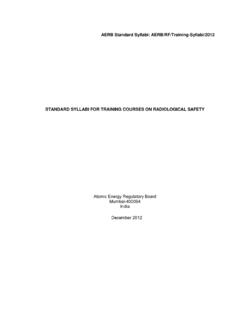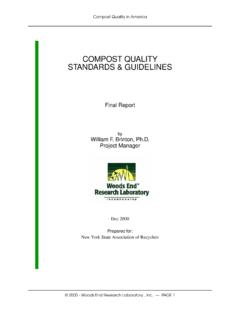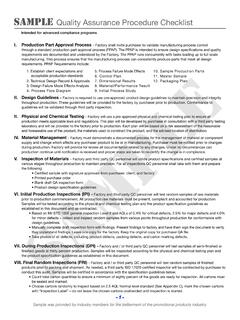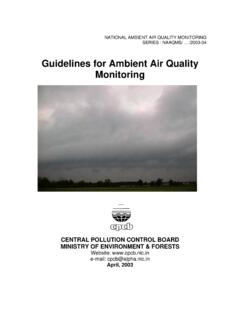Transcription of Quality Asuurance of Diagnostic X-Ray Equipment
1 Radiation Safety Training Module: Diagnostic Radiology Quality assurance in Diagnostic Radiology Radiological Safety Division Atomic Energy Regulatory Board Content Expected questions to know after studying this lecture Introduction Need of QA Aim of QA Parameters tested for QA Quality assurance Tests for Diagnostic X-Ray Equipment Summary Steps for population dose reduction from Diagnostic uses of radiation Expected Questions References and sources for additional information Expected questions to know after studying this lecture What do you mean by QA in Diagnostic Radiology? Why QA tests are required? Understanding the concepts of various QA tests. Understanding the importance of various QA tests Introduction Definition: Quality assurance (QA) of medical Diagnostic X-Ray Equipment means systematic actions necessary to provide adequate confidence to the end-user(s) that a medical Diagnostic X-Ray Equipment will perform satisfactory in compliance with safety standards specified by the Competent Authority.
2 QA Programme The goal of QA Program is to ensure the accuracy of the diagnosis. The minimum radiation dose should be delivered to the patient to achieve the objective of the Diagnostic or interventional procedures. QA programme begins with the performance evaluation of Diagnostic X-Ray Equipment at the manufacturing stage and then acceptance testing after the installation of X-Ray Equipment at user s institution(s) to ensure its conformity with the specifications. The QA tests should be carried out thereafter at regular intervals (periodicity-once in two years) and also after repairs of the Equipment or when Equipment malfunction is suspected. Objective / Aim of Quality assurance (QA) Optimum image Quality of radiological procedures with minimum possible dose to the patient(s) TYPE APPROVAL TEST Type approval tests of an Equipment are carried out to verify the performance of Equipment as per safety requirements of AERB Safety Code and the Safety Standards are in force.
3 Result of type approval tests should meet the tolerances values as specified in Type Approval QA Protocol(s). Type approval tests are performed on prototype model of X-Ray Equipment . Type Approval becomes invalid if any change is made in the design specifications of the type approved model. It is the responsibility of the manufacturer/supplier to ensure that type approved X-Ray Equipment shall be marketed in the country. Why QA in Diagnostic Radiology? To get calibrate all the exposure parameters, to check functional performance of X-Ray Equipment and radiation safety around the X-Ray installation, QA checks are necessary for every Diagnostic X-Ray Equipment . In other words, to obtain the optimum Quality Diagnostic information at the lowest radiation risk to the patient, QA of Diagnostic X-Ray Equipment is necessary. Quality assurance Test The routine QA tests are necessary to ensure that the functional performance of the Equipment is similar to its baseline values and within the tolerance values as specified by regulatory body.
4 These tests should be performed by qualified service engineer(s) at user institution(s). These tests should be performed at regular intervals (once in two years) and at major repairs of X-Ray Equipment . MAMMOGRAPHY Diagnostic RADIOLOGY COMPUTED TOMOGRAPHY RADIOGRAPHY & FLUOROSCOPY OPG INTERVENTIONAL RADIOLOGY Multiometer Survey meter CATPHAN QA Tests Equipment Al filter Tissue Equivalent Phantom Parameters affecting image Quality Operating Potential Operating Current Exposure Time Effective Focal Spot Size Total Filtration Leakage from tube housing Detector Characteristics Quality assurance Tests for Diagnostic X-Ray Equipment Congruence of radiation and optical fields Central beam alignment Effective Focal spot size measurement Timer Accuracy Accuracy of Accelerating Tube Potential Linearity of radiation output Reproducibility of radiation output Total filtration Radiation leakage through tube housing Exposure rate at tabletop Fluoroscopic image Quality parameters Congruence of Radiation and Optical Fields The X-Ray field must be aligned with the light field so that the operator can accurately position the body part to be
5 Imaged. If the optical field and radiation field are not congruent, the area of clinical interest may be missed in the radiograph leading to retakes and unnecessary radiation exposure to patients. Tolerance: | a1 | + |a2 | of S Here S represents the focal spot to image receptor distance and a1 and a2 are the discrepancies in one dimension of imaging field. Congruence of Radiation and Optical Fields and Beam Alignment Beam alignment test tool Central Beam Alignment If the X-Ray beam is not perpendicular to the image receptor, the image may be distorted. If grid is used, the distortion will be magnified resulting in complete loss of minute details. Beam alignment test can be done simultaneously with the test for congruence of optical and radiation field Tolerance Central beam alignment < Quality assurance Tests for Diagnostic X-Ray (R/R&F) Effective Focal Spot Size measurements: Focal Spot size is defined in two ways: The actual focal spot size is the area on the anode that is struck by electrons and it is primarily determined by the length of cathode filament and the width of the focusing cup slot.
6 The effective focal spot size is the length and width of the focal spot as projected down the central ray in the X-Ray field. The effective focal width is equal to the actual focal width and therefore is not affected by the anode angle. However, the anode angle causes the effective focal spot length to be smaller than the actual focal spot length. Effective focal length = Actual focal length x Sin Here, is the anode angle Quality assurance Tests for Diagnostic X-Ray (R/R&F) Effective Focal Spot Size Measurements: Tools used for effective focal spot size measurements: Pinhole camera Slit camera Star pattern Resolution bar pattern Tolerance: for f < mm + f for f mm + f for f > mm + Bar pattern images demonstrate the effective resolution parallel and perpendicular to the A-C axis for a given magnification geometry. Accelerating Potential (kVp) The peak potential of the X-Ray generator affects Quality of the X-Ray beam and exposure to the patient.
7 Presently solid state detectors, which employ non-invasive method for peak tube potential measurement are quite handy for this test. Assessment of the tube potential ensures that the delivered kVp is close to that set on the Equipment by the operator. Accelerating Potential (kVp) Tolerance : 5 kV Accuracy of Exposure Timer If the exposure time of the X-Ray unit is not in order, the radiograph can be under exposed or overexposed. For this, absolute timer method is adopted by measuring set and measured time with digital timers. Tolerance: Accuracy of exposure timer % Error 10 % Linearity of mA loading stations The tube current (mA) is equal to the number of electrons flowing from the cathode to the anode per unit time. The exposure of the beam for a given kVp and filtration is proportional to the tube current. This test is carried out to check the linearity of radiation output with respect to change in tube current (mA) stations by keeping timer station constant at a particular kV station.
8 Linearity of mA loading stations ( ) FFD=100 cm Radiation field size = 20 cm x 20 cm Keeping exposure time and kVp constant, radiation output is measured at different mA stations. Measurement for mA loading station is to be repeated for a number of times each to eliminate statistical errors. Radiation output readings of each mA loading station readings are averaged and the coefficient of linearity (CoL) is evaluated from average mR/mAs or mGy/mAs as follows: Tolerance: Coefficient of Linearity Dose measuring instrument Coefficient of linearity = (X max -Xmin ) (Xmax + X min) Linearity of timer loading stations The exposure time is the duration of X-Ray production. Keeping the kVp and mA constant, radiation output is measured at different timer stations and Coefficient of Linearity is evaluated. This test is carried out to check the linearity of radiation output with respect to change in timer stations by keeping mA station constant at a particular kV station.
9 Tolerance: Coefficient of timer linearity < Out put Consistency To check the constancy of radiation output Keeping fixed mA and time, radiation output is measured at various available kV stations. Average(X) of ( mR/mAs) or (mGy/mAs) is calculated. Consistency at each kV station is checked by evaluating the coefficient of variation. Coefficient of variation COV = 1/ X x [( (Xi- X)2 ) /(n-1)] Tolerance : Coefficient of Variation Total Filtration of X-Ray tube To cutoff low energy components from X-Ray beam, which do not contribute to Diagnostic image formation but result in unnecessary patient exposure. If the filtration is too high, image contrast will be poor and unit will be overloaded. Therefore it is necessary that the total filtration (inherent + added) provided for the X-Ray tube be as per the recommended value. The determination of half value thickness (HVT) of the X-Ray beam is the method of evaluation of total aluminum equivalent filtration of the X-Ray tube.
10 Evaluation of HVL and Total Filtration 0102030405060708090100012345 Transmission (%)Thickness of added Aluminium filters (mm) Total aluminum equivalent filtration of the X-Ray tube is evaluated by determining the half value thickness of the beam. Transmission curve of the X-Ray beam can be prepared by plotting a graph between the absorber thickness and corresponding percentage transmission. The absorber thickness for 50 % transmission will be the half value thickness of the X-Ray beam. Total aluminum filtration could be determined from HVT using calibration tables. Presently, new solid state detectors directly gives the values of HVT and total filtration used in Diagnostic X-Ray Equipment . Minimum Filtration for X-Ray tubes For ensuring radiation Quality of the X-Ray beam, the total filtration in the X-Ray source assembly shall comply with the Half- Value Layer requirements. Material Used : Aluminum filters of purity or higher and density g cm-3 Tolerance : mm Al for kV 70 mm Al for 70 kV 100 mm Al for kV 100 Aluminum Equivalence of table top (Couch) mm Al Radiation Leakage Levels from Tube housing The radiation leakage measurement is carried with an ionization chamber/semiconductor based radiation survey meter.















